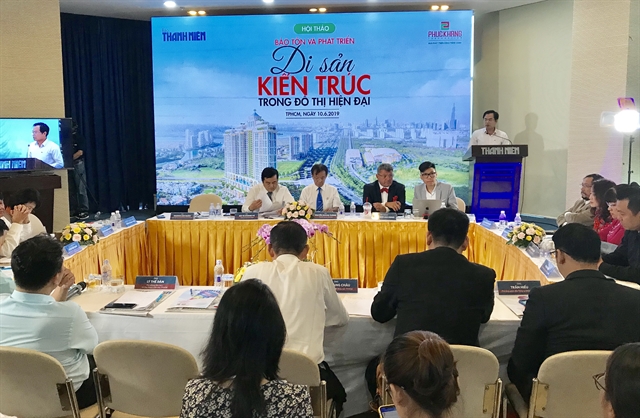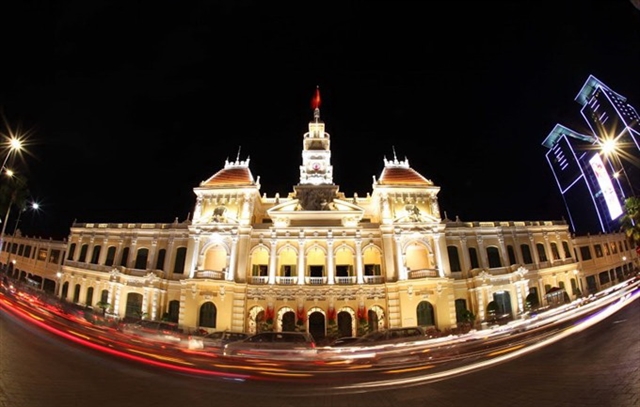
Speakers at a recent conference on preservation of the city's built heritage held in HCM City. VNS Photo Bồ Xuân Hiệp
HCM City should develop a heritage master plan as part of its urban development strategy to ensure conservation of its architectural heritage, experts have urged.
Speaking at a conference on architectural heritage held by Thanh Niên (Youth) newspaper recently, experts said the master plan must ensure balance between urbanisation and preservation of the city’s remaining heritage.
Nguyễn Quang Thông, editor-in-chief of the newspaper, emphasised the great value that architectural heritage can bring to the city’s economy. “Our architectural legacy is a symbol here and around the world. Some of these have become national brands.”
According to Bùi Tá Hoàng Vũ, director of the HCM City Tourism Department, architectural heritage greatly contributes to the city’s tourism industry. However, the number of tourism heritage sites in the city is a relatively modest 258, of which only 111 are potential tourist attractions.
The city has a total of 172 historic relics but only 30 per cent of them can be promoted as tourist attractions. Among the 10 must-see landmarks in the city are all historic buildings.
Economic value
Trần Văn Khải, of the HCM City University of Architecture, said that most people were unaware of the economic value of built heritage.
Many foreign tourists believe HCM City today is not considered a city of culture or heritage. For them, the city is just a stopover.
Most city tours today include only a few attractions such as the Post Office, the Notre Dame Cathedral, the Independence Palace, Bến Thành Market and the War Remnants Museum.
Experts attributed the problem to the city’s lack of a comprehensive heritage inventory.
Architectural heritage must be credited for its potential economic value, they said.
In other countries, historic buildings are preserved for aesthetic reasons as well as for the huge economic benefits they offer.
Destruction of historic heritage could result in a drop in the number of cultural tourists who are believed to stay longer, take part in more cultural activities, and spend more money.
The number of tourists to the city has continued to increase annually, reaching 6.4 million in 2017, a rise of nearly 23 per cent over the previous year. However, the average visitor stay is only 2.6 days.
Worse still, only a small number of first-time visitors ever return to the city.

HCM City People’s Committee in District 1. VNA/VNS Photo Mạnh Linh
Recommendations
Nguyễn Thị Hậu, an archaeologist who is secretary general of HCM City History Science Association, told Việt Nam News: “The government, property developers, researchers and the entire community all play a decisive role in preserving the city’s architectural heritage.”
Architect Nguyễn Hạnh Nguyên, of the HCM City University of Architecture, said it was important to help the historic buildings’ owners understand the economic value of their properties so they will be willing to spend money to preserve them.
Architect Cao Thanh Nghiệp, a member of the HCM City Architects Association, said that businesses can preserve and promote the value of a land lot where a built heritage is located.
“Planning and design solutions must ensure benefits for investors while ensuring the heritage value,” he said.
Experts also recommended the city conduct a comprehensive inventory of the city’s historic buildings.
They said legal protection should be extended to all historic and architectural buildings, and that enforcement and punishment of violators should be strengthened.
In addition, the city should provide economic incentives for the conservation of privately owned historic buildings, to ensure owners have benefits when protecting the buildings.
HCM City has about 3,000 valuable old houses and villas that could be preserved properly, but are likely to be demolished, according to the Architecture Research Centre at the city’s Department of Planning and Architecture.
Of that number, nearly 1,300 houses were built before 1975. About 168 of them are under State management and receive funds from the city’s budget for repair and preservation.
However, only eight buildings remain in good conditions, according to the Urban Research and Development Centre.
Valuable old buildings, mostly built during the French colonial period, include the HCM City People’s Court (built in 1881), King’s Palace or Revolutionary Museum (1885), Majestic Hotel and Notre Dame Cathedral (1887), Sài Gòn Post Office (1886-1891), HCM City’s People’s Committee (1907), Opera House (1900) and Bến Thành Market (1912-1914).
Many colonial villas have been renovated and now house schools, restaurants and coffee shops, most of which are located in District 3 on Tú Xương, Võ Văn Tần, Nguyễn Đình Chiểu, Lê Quý Đôn and Trần Quốc Thảo streets.
In recent years, however, many old houses and villas have been demolished or have fallen into disrepair.
A large number that are private properties have not been taken care of properly. Some of the villas are so dilapidated they are no longer habitable.
It is estimated that more than a third of the city’s historic buildings have been destroyed over the past two decades.
HCM City authorities are putting some 1,000 historic buildings into three classifications: class one (must be protected); class two (owner can build on the lot but cannot destroy the old building); and class three (can be demolished).
Experts say that people are not aware that when they destroy historic buildings they are in fact losing a potential economic value. VNS
OVietnam